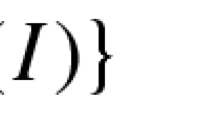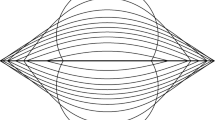Abstract
In this paper we study the \(L^2\)-gradient flow of the penalized elastic energy on networks of q-curves in \(\mathbb {R}^{n}\) for \(q \ge 3\). Each curve is fixed at one end-point and at the other is joint to the other curves at a movable q-junction. For this geometric evolution problem with natural boundary condition we show the existence of smooth solutions for a (possibly) short interval of time. Since the geometric problem is not well-posed, due to the freedom in reparametrization of curves, we consider a fourth-order non-degenerate parabolic quasilinear system, called the analytic problem, and show first a short-time existence result for this parabolic system. The proof relies on applying Solonnikov’s theory on linear parabolic systems and Banach fixed point theorem in proper Hölder spaces. Then the original geometric problem is solved by establishing the relation between the analytical solutions and the solutions to the geometrical problem.
Similar content being viewed by others
Notes
In our case \(\xi \) is a vector in \(\mathbb {R}\) but in the general setting of [19] \(\xi \in \mathbb {R}^d\). Now working at the boundary one uses the tangential \(\zeta \) and normal \(\tau \) directions of the vector \(\xi \). Since we are in dimension one there is no tangential direction, i.e. \(\zeta =0\).
In the notation of Solonnikov \(L=L(\tau )\) has \(b\cdot r=2\cdot qn=2qn\) roots with negative imaginary parts and 2qn with negative imaginary parts.
References
Barrett, J. W., Garcke, H., and Nürnberg, R. Elastic flow with junctions: variational approximation and applications to nonlinear splines. Math. Models Methods Appl. Sci. 22, 11 (2012).
Bronsard, L., and Reitich, F. On three-phase boundary motion and the singular limit of a vector-valued Ginzburg-Landau equation. Arch. Rational Mech. Anal. 124, 4 (1993), 355–379.
Buxton, G. A., and Clarke, N. “Bending to stretching” transition in disordered networks. Phys. Rev. Lett. 98 (2007), 238103.
Dall’Acqua, A., Lin, C.-C., and Pozzi, P. Elastic of networks: long-time existence result. Geom. Flows 4, 1 (2019), 83–136.
Dall’Acqua, A., Novaga, M., and Pluda, A. Minimal elastic networks. accepted by Indiana University Mathematics Journal (2017).
Dall’Acqua, A., and Pozzi, P. A Willmore-Helfrich \(L^2\)-flow of curves with natural boundary conditions. Comm. Anal. Geom. 22, 4 (2014), 617–669.
Dall’Acqua, A., and Spener, A. The elastic flow of curves in the hyperbolic plane. preprint, arXiv:1710.09600 (2017).
Del Nin, G., Pluda, A., and Pozzetta, M. Degenerate elastic networks. Preprint 2019.
Dziuk, G., Kuwert, E., and Schätzle, R. Evolution of elastic curves in \({\mathbb{R}}^n\): existence and computation. SIAM J. Math. Anal. 33, 5 (2002), 1228–1245 (electronic).
Eidelman, S. D., and Zhitarashu, N. V. Parabolic boundary value problems, vol. 101 of Operator Theory: Advances and Applications. Birkhäuser Verlag, Basel, 1998. Translated from the Russian original by Gennady Pasechnik and Andrei Iacob.
Garcke, H., Menzel, J., and Pluda, A. Willmore flow of planar networks. J. Differential Equations 266, 4 (2019), 2019–2051.
Garcke, H., Menzel, J., and Pluda, A. Long time existence of solutions to an elastic flow of networks. Comm. Partial Differential Equations (to appear) (2020), 1–53.
Gößwein, M., Menzel, J., and Pluda, A. Existence and uniqueness of the motion by curvature of regular networks. Preprint 2020.
Gurtner, G., and Durand, M. Stiffest elastic networks. Proc. R. Soc. A 470 (2014), 20130611.
Lee, E. H., and Forsythe, G. E. Variational study of nonlinear spline curves. SIAM Rev. 15 (1973), 120–133.
Mantegazza, C., Novaga, M., Pluda, A., and Schulze, F. Evolution of networks with multiple junctions. preprint (2016).
Novaga, M., and Pozzi, P. A second order gradient flow of \(p\)-elastic planar networks. SIAM J. Math. Anal. 52, 1 (2020), 682–708.
Polden, A. Curves and surfaces of least total curvature and fourth-order flows. PhD Thesis, Universität Tübingen (1996).
Solonnikov, V. A. Boundary Value Problems of Mathematical Physics. III. No. 83 in Proceedings of the Steklov institute of Mathematics (1965). Amer. Math. Soc., Providence, RI, 1967.
Stanko, T., Hahmann, S., Bonneau, G.-P., and Saguin-Sprynski, N. Shape from sensors: Curve networks on surfaces from 3d orientations. Computers and Graphics 66 (2017), 74–84.
Truesdell, C. The influence of elasticity on analysis: the classic heritage. Bull. Amer. Math. Soc. (N.S.) 9, 3 (1983), 293–310.
Acknowledgements
This project has been funded by the Deutsche Forschungsgemeinschaft (DFG, German Research Foundation)- Projektnummer: 404870139, and Ministry of Science and Technology, Taiwan (MoST 107-2923-M-003-001-MY3). We also thank the anonymous referee for valuable comments.
Author information
Authors and Affiliations
Corresponding authors
Additional information
Publisher's Note
Springer Nature remains neutral with regard to jurisdictional claims in published maps and institutional affiliations.
Appendices
A Supporting materials
Here we collect some useful formulas. For \(f: I \rightarrow \mathbb {R}^{n}\) a regular parametrization of a curve and for sufficiently smooth \(\phi :I \rightarrow \mathbb {R}^n\) the first variation of the length is given by
while the first variation of elastic energy (see [6, Proof of Lemma A1]) is
Moreover,
In particular it follows for the velocity in (1.8)
Remark A.1
Let \(f:[0,1] \rightarrow \mathbb {R}^n\) be a regular sufficiently smooth curve parametrized by constant speed (equal to its length), that is \(|\partial _x f|\equiv L(f)\) on [0, 1]. Then \( \langle \partial _x f, \partial _x^2 f\rangle =0\), \(|\partial _x^2 f|^2+ \langle \partial _x f, \partial _x^3 f\rangle =0\), \( \mathbf {\kappa }= \frac{\partial _x^2 f}{|\partial _x f|^{2}}\) and \(3 \langle \partial _x^2 f, \partial _x^3 f\rangle +\langle \partial _x f, \partial _x^4 f\rangle =0\) so that (with similar calculations as in (A4)) we immediately obtain
B Function spaces
Our short-time existence theory uses parabolic Hölder spaces, which are defined as follows. Following [19, page 66], for a function \(v : [0,T] \times [0,1] \rightarrow \mathbb {R}\) and \(\rho \in (0,1)\) let
As in [19, pages 91 and 66] we define
to be the space of all maps \(v : [0,T] \times [0,1] \rightarrow \mathbb {R}\) with continuous derivatives \(\partial _{t}^{i}\partial _{x}^{j}v\) for \(i, j \in \mathbb {N}\cup \{0 \}\) with \(4i+j \le k\) and such that the norm
is finite. Notice that in the last term we sum over i, j’s satisfying the inequality. In the proofs, in order to avoid lengthy notation, we do not write the set when considering the parabolic Hölder spaces. That is we write simply \(\Vert v \Vert _{C^{\frac{k+\alpha }{4}, k+\alpha }}\) instead of \(\Vert v \Vert _{ C^{ \frac{k+\alpha }{4}, k+\alpha }([0,T] \times [0,1]) }\). When considering the Hölder norms in only one variable we always write the set, for instance in \(C^{4,\alpha }([0,1])\) or \(C^{0,\frac{\alpha }{4}}([0,T])\).
When dealing with vector-valued maps we use the convention that the \(C^{\frac{k+\alpha }{4},k+\alpha }\) -norm of the vector is the sum of the norms of its components.
Remark B.1
From the definition it follows that for \(m\le k\), \(m,k \in \mathbb {N}_0\)
and if \(v \in C^{ \frac{k+\alpha }{4}, k+\alpha }([0,T]\times [0,1])\), then \(\partial _x^l v \in C^{ \frac{k-l+\alpha }{4}, k-l+\alpha }([0,T]\times [0,1])\) for all \(0 \le l\le k\) so that
In particular at each fixed \(x \in [0,1]\) we have \(\partial _x^l v (\cdot ,x )\in C^{s,\beta }([0,T])\) with \(s =[\frac{k-l+\alpha }{4}]\) and \(\beta = \frac{k-l+\alpha }{4}-s\).
We will use often the following properties of the Hölder norms.
Lemma B.2
For \(k \in \mathbb {N}_0\), \(\alpha ,\beta \in (0,1)\) and \(T>0\) we have
-
1.
if \(v,w \in C^{\frac{k+\alpha }{4},k+\alpha }([0,T]\times [0,1])\), then
$$\begin{aligned} \Vert v w \Vert _{C^{\frac{k+\alpha }{4},k+\alpha }} \le C \Vert v \Vert _{C^{\frac{k+\alpha }{4},k+\alpha }} \Vert w \Vert _{C^{\frac{k+\alpha }{4},k+\alpha }} , \end{aligned}$$with \(C=C(k)>0\);
-
2.
if \(v\in C^{\frac{\alpha }{4},\alpha }([0,T]\times [0,1])\), \(v(t,x)\ne 0\) for all (t, x), then
$$\begin{aligned} \Big \Vert \frac{1}{v} \Big \Vert _{C^{\frac{\alpha }{4},\alpha }} \le \Big \Vert \frac{1}{v} \Big \Vert ^2_{C^{0}([0,T]\times [0,1])} \Vert v \Vert _{C^{\frac{\alpha }{4},\alpha }} . \end{aligned}$$
Similar statements are true for functions in \(C^{k,\beta }([0,T])\) and \(C^{k,\beta }([0,1])\).
Proof
It follows by the definition of the norms and direct computation.\(\square \)
Lemma B.3
For \(n \in \mathbb {N}\), \(k \in \mathbb {N}_0\), \(\alpha ,\beta \in (0,1)\) and \(T>0\) we have
-
1.
if a vector-field \(v\in C^{\frac{\alpha }{4},\alpha }([0,T]\times [0,1];\mathbb {R}^n)\), then
$$\begin{aligned} \Vert \, |v|\, \Vert _{C^{\frac{\alpha }{4},\alpha }} \le C \Vert v \Vert _{C^{\frac{\alpha }{4},\alpha }} , \end{aligned}$$with \(C=C(n)\).
-
2.
for \(v, w\in C^{\frac{\alpha }{4},\alpha }([0,T]\times [0,1];\mathbb {R}^n)\) we have
$$\begin{aligned} \Vert \, |v|- |w|\, \Vert _{C^{\frac{\alpha }{4},\alpha }} \le C \left\| \frac{1}{|v|+|w|} \right\| ^{2}_{C^{0} ([0,T]\times [0,1])} (\Vert v \Vert _{C^{\frac{\alpha }{4},\alpha }} + \Vert w\Vert _{C^{\frac{\alpha }{4},\alpha }} )^{2} \Vert v-w \Vert _{C^{\frac{\alpha }{4},\alpha }} \end{aligned}$$
with \(C=C(n)\). Similar statements are true for functions in \(C^{k,\beta }([0,T])\) and \(C^{k,\beta }([0,1])\).
Proof
The main observation is that one has to be careful about the treatment of the Hölder seminorms. The first statement relies on the equivalence of the \(l_{2}\)-norm and \(l_{1}\)-norm in \(\mathbb {R}^{n}\), which gives
for any vector valued map v. The last inequality is needed because of our convention for the Hölder norm of a vector valued function. For the second statement, the aim is to manipulate the considered map in such a way that it is written as a product of functions and we can apply the previous lemma. We can write
and the claim follows.\(\square \)
We will also need that the composition of Hölder functions is again Hölder. Here one needs to pay attention since, in general, if \(f \in C^{0,\alpha }(I), g\in C^{0,\beta }(I)\) then \(f \circ g \in C^{0,\alpha \beta }(I)\), i.e. the Hölder exponent of the composition is given by the product of the Hölder exponents. Therefore, in order not to lose in regularity by applying directly this rule, we need to look carefully at the terms we are working with. In particular we exploit that we always consider the convolution of a Hölder map with a diffeomorphism and hence we do not lose in the Hölder power.
Remark B.4
If \(f_0\in C^{k,\alpha }([0,1])\), \(k \ge 4\), then the diffeomorphism v defined as in (4.1) is also in \(C^{k,\alpha }([0,1])\) by the previous lemmata. By direct verification we find that also \(\phi :=v^{-1}\) belongs to \(C^{k,\alpha }([0,1])\). Then \((\partial _x^i f_0)\circ \phi \in C^{0,\alpha }([0,1])\) for \(0\le i \le k\) thanks to the fact that \(\phi \) is a diffeomorphism and hence in particular in \(C^{0,1}([0,1])\). Since \(\partial _x^k (f_0 \circ \phi )\) is a polynomial in the maps \((\partial _x^i f_0)\circ \phi \) and (several products of) \(\partial _x^j \phi \), for \(1 \le i \le k\), \(1 \le j\le k\), we see that \( f_0 \circ \phi \in C^{k,\alpha }([0,1])\).
Lemma B.5
Let \(T<1\) and \(v \in C^{ \frac{4+\alpha }{4}, 4+\alpha }([0,T]\times [0,1])\) such that \(v(0,x)= 0\), for any \(x \in [0,1]\) then
for all \(l,m \in \mathbb {N}_0\) such that \(l+m<4\). Here \(\beta =\max \{ \frac{1-\alpha }{4}, \frac{\alpha }{4} \} \in (0,1)\); more precisely for \(l\ge 1\) then \(\beta =\frac{\alpha }{4}\).
In particular, for each \(x \in [0,1]\) fixed
for all \(l,m \in \mathbb {N}_0\) such that \(l+m<4\).
Proof
Since by definition of the norm we have (recall \(m,l <4\))
we observe that for \(j \in \{ 0, \ldots , m \}\), \(0<l+j \le l+m < 4\), and we have
Instead, for the case \(j=l=0\) we compute
Next, with similar ideas, using the fact that \(|x-y| \le 1\) and \( l+m +1\le 4\) we compute
and for \( j\in \{0, \ldots , m \}\)
The above computation makes sense except for the case \(m=3\), \(j=0\) (and hence \(l=0\)), for which \(\frac{m+\alpha +1 -j}{4} >1\). The case \(m=3\), \(l=j=0\) is treated as follows
Finally putting all estimates together and recalling that \(l+j \le l+m \le 3\), \(T<1\) and \(\alpha <1\) we obtain (here for \(m<3\), for \(m=3\) the arguments are similar)
and the first estimate follows. The second part of the claim follows from the observation that
due to (B1).\(\square \)
C Diffeomorphisms
With the following lemma we show the existence of a diffeomorphism, which transforms a solution of the geometric problem into a solution of the analytical one.
Lemma C.1
Let \(\{f_{1}, \ldots , f_{q}\}\), with \(f_{i}:[0,T] \times [0,1] \rightarrow \mathbb {R}^{n}\), be a \(C^{\frac{4+\alpha }{4},4+\alpha } ( [0,T] \times [0,1]; \mathbb {R}^n)\) solution of (1.8) and (1.6) with initial datum \(\{f_{0,1}, \ldots , f_{0,q}\}\) that satisfies (1.7), (1.9) and (1.10), i.e. a geometric solution in the sense of Theorem 1.2. Then there exists \(T' \in (0,T)\) and orientation preserving diffeomorphisms \(\phi _{i}(t, \cdot )\) with \(\phi _{i} \in C^{\frac{4+\alpha }{4},4+\alpha }( [0,T'] \times [0,1] ,\mathbb {R})\), such that \(\tilde{f}_{i}(t,y):= f_{i} (t, \phi _i(t,y))\), \(i=1, \ldots , q\), are in \(C^{\frac{4+\alpha }{4},4+\alpha }( [0,T'] \times [0,1] ,\mathbb {R}^n)\) and solve the analytical problem (2.2) together with (2.4) (with the obvious notation changes) and with initial datum \(f_{0,i} \circ \phi _{i}(t=0, \cdot )\), that is \(\{\tilde{f}_{1}, \ldots , \tilde{f}_{q}\}\) is the unique solution of the analytical problem with initial datum \(f_{0,i}\) opportunely reparametrized.
Proof
Let \(\{f_{1},f_{2},\ldots , f_{q}\}\) be as in the statement. Let \(\varphi _i\) be the tangential component of the velocity of \(f_i\), that is
for \((t,x) \in [0,T] \times [0,1]\). By (1.7), (1.9), (1.10) the initial datum \(f_{0,i}\), \(i\in \{1, \dots ,q\}\), satisfies (NC) and at the boundary points \(x=0,1\)
For each \(i \in \{1,\ldots , q\}\), fix a smooth diffeomorphism \(\psi _i:[0,1] \rightarrow [0,1]\) such that \(\partial _y \psi _i >0\) on [0, 1] and
as well as
whereby recall that \(\varphi _{0,i}(1)=0.\) There are many ways to give a diffeomorphism with the above properties. To simplify the construction, let us further impose that
Then \(\psi _{i}\) can be given as a perturbation of the identity map, with a similar construction as performed in the proof of Theorem 1.2, the main difference beeing that now we have two smooth cut-off functions \(\tilde{\eta }_{0}\), \(\tilde{\eta }_{1}:[0,1] \rightarrow [0,1]\) such that \(\tilde{\eta }_{0}\) is equal to one near the origin, \(\tilde{\eta }_{1}\) is equal to one near to \(y=1\), \(supp (\tilde{\eta }_{0})\) and \(supp (\tilde{\eta }_{1})\) are small and well separated, and with \(\tilde{\eta }_{0}\), \( \tilde{\eta }_{1}\) dropping to zero sufficiently fast to guarantee that \(\partial _{y} \psi _{i}>0\) everywhere. More precisely \(\psi _{i}:[0,1] \rightarrow [0,1]\) is given by
with appropriately chosen coefficients \(b_{j}\), \(c_{j}\), \(j=0,1\), that depend on the values of \(f_{0,i}\) and \(\varphi _{0,i}\) at the boundary.
For later purposes let us observe that the inverse \(\psi _i^{-1}\) satisfies \(\partial _{x}(\psi _i^{-1})>0\) and
Consider now for fixed \(i \in \{1,\ldots ,q\}\) the evolution equation
with boundary conditions
for all t and initial condition
Since at the boundary points
using (C4) we infer that the right-hand side of (C3) is given by
therefore, by (C2), our initial data \(\psi _i\) satifies compatibility conditions of order zero.
The idea is that \(\tilde{f}_i:=f_i \circ \phi _i\) is a solution of the analytical problem with initial datum \(f_{i,0} \circ \psi _i\), \(i \in \{1,\ldots ,q\}\). As a first step one should prove existence of solutions \(\phi _i\) to (C3), (C4) with (C5). One could proceed as in Sect. 3 to prove existence of a solution. By doing this one notices that, for instance, the term \(\varphi _i(t, \phi _i(t,y))\) creates a problem in the contraction argument since the tangential component \(\varphi _i\) is only \(C^{\frac{\alpha }{4},\alpha } \) (since it depends also on \(\partial _x^4 f_i\)). To avoid this problem we follow an idea presented in [13] and look instead for the evolution equation satisfied by the inverse of the diffeomorphisms \(y \mapsto \phi _i(t,y)\). Let \(\eta _{i}= \eta _{i}(t,x)\) be such that \(\eta _{i}(t, \phi _{i}(t,y))=y\) for \(y\in [0,1]\). Since
we find that the evolution equation for the inverse reads
with boundary conditions
and initial condition
Note that by (C6) and (C8) the right hand side of (C7) at the boundary points is given by
We see that by the conditions satisfied by \(\psi _{i}^{-1}\) at the boundary also for this equation the compatibility condition of order zero are satisfied. Observe that \(\eta _{i}\) satisfies a linear parabolic problem of fourth order with linear boundary conditions (as opposed to its inverse \(\phi _{i}\)). Standard linear parabolic theory (see [19]) applies so that we obtain the existence of a solution \(\eta _{i} \in C^{\frac{4+\alpha }{4},4+\alpha }( [0,T] \times [0,1] ,\mathbb {R})\). Since \(\eta _i(0, \cdot )\) is a diffeomorphism, by possibly reducing the time interval we can ensure that \(\eta _{i}(t, \cdot )\) is a family of diffeomorphsim on \([0, T']\) for some \(0<T' \le T\). The existence of \(\eta _{i}\) yields the existence of its inverse \(\phi _{i}\).
Finally, by a direct computation one sees that \(\tilde{f}_i:=f_i \circ \phi _i\) is a solution of the analytical problem with initial datum \(f_{0,i} \circ \psi _i\), \(i \in \{1,\ldots ,q\}\). Indeed,
and the computations performed in (A4), or the formula (2.2) and (2.3), yield
where
Note that \(\partial _{y}\tilde{f}_i (t,y) = \partial _{x}f_i (t, \phi _i(t,y)) \partial _{y}\phi _i (t,y)\) and
Using that \(\mathbf {\kappa }_{i}=0\) at the boundary, we can immediately verify that \(\partial _{y}^{2}\tilde{f}_i (t,y)=0\) at \(y=0,1\) for all times. Moreover with (C4) and (C6) we obtain at the boundary
Therefore at time \(t=0\), using the compatibility conditions for \(\phi _i\) (i.e. our choice of \(\psi _i\)) and the expression for \(\nabla _{s}^{2} \mathbf {\kappa }_{0,i}\) we obtain at \(y=0,1\)
so that we immediately derive that the Compatibility conditions 2.1 for the analitical problem are verified. Next, since \(\partial _y \phi _i>0\) we verify that \(\mathcal {R}_{i}=\varphi _i+ |\partial _x f_i| \partial _t \phi _i\). This, together with (C9) and (C10) shows that indeed, \(\tilde{f}_i:=f_i \circ \phi _i\) solves (2.2) and (2.4).\(\square \)
Rights and permissions
About this article
Cite this article
Dall’Acqua, A., Lin, CC. & Pozzi, P. Elastic flow of networks: short-time existence result. J. Evol. Equ. 21, 1299–1344 (2021). https://doi.org/10.1007/s00028-020-00626-6
Accepted:
Published:
Issue Date:
DOI: https://doi.org/10.1007/s00028-020-00626-6




